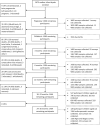Aflatoxin exposure and child nutrition: measuring anthropometric and long-bone growth over time in Nepal
- PMID: 33677532
- PMCID: PMC8023848
- DOI: 10.1093/ajcn/nqaa397
Aflatoxin exposure and child nutrition: measuring anthropometric and long-bone growth over time in Nepal
Abstract
Background: Naturally occurring aflatoxins may contribute to poor growth and nutritional statuses in children.
Objectives: We analyzed the relationship between contemporary and lagged aflatoxin exposure and 1) length-for-age z-score (LAZ); and 2) length, knee-heel length, stunting, weight-for-age z-score (WAZ), and weight-for-length z-score (WLZ).
Methods: We conducted a longitudinal birth cohort study involving 1675 mother-infant dyads in rural Nepal. Participants were repeatedly visited from pregnancy to 2 years of age (2015-2019). One blood sample was collected during pregnancy and 4 samples were collected from the children at 3, 6, 12, and 18-22 months of age to measure concentrations of aflatoxin B1 (AFB1)-lysine adduct. Multivariate linear fixed-effects and logistic models with generalized estimating equations were used to identify associations between child growth and aflatoxin exposure.
Results: AFB1-lysine adducts were detected in the majority of children (at 3 months, 80.5%; at 6 months, 75.3%; at 12 months, 81.1%; and at 18-22 months, 85.1%) and in 94.3% of pregnant women. Changes in contemporary ln child AFB1-lysine adduct concentrations were significantly associated with changes in LAZ (β, -0.05; 95% CI, -0.09 to -0.02; P = 0.003), length (β, -0.19; 95% CI, -0.29 to -0.10; P < 0.001), knee-heel length (β, -0.09; 95% CI, -0.13 to -0.05; P < 0.001), and WAZ (β, -0.04; 95% CI, -0.07 to -0.005; P = 0.022). Serum aflatoxin concentrations were associated with stunting (OR, 1.18; 95% CI, 1.05-1.32; P = 0.005). Similar results were found in the models using changes in contemporary ln AFB1 adjusted for changes in child weight, with significant associations with changes in WLZ (β, -0.07; 95% CI, -0.10 to -0.03; P < 0.001). Changes in time-lagged ln AFB1 (unadjusted and adjusted for changes in child weight) were associated with changes in length and knee-heel length.
Conclusions: Our results add to the growing body of evidence confirming chronic aflatoxin exposure and suggest that exposure is significantly correlated with various negative growth outcomes, which may vary by child weight status. This trial was registered at clinicaltrials.gov as NCT03312049.
Keywords: aflatoxin; growth; knee-heel length; length-for-age; weight; weight-for-age; weight-for-length.
© The Author(s) 2021. Published by Oxford University Press on behalf of the American Society for Nutrition.
Figures

References
-
- Turner PC, Collinson AC, Cheung YB, Gong Y, Hall AJ, Prentice AM, Wild CP. Aflatoxin exposure in utero causes growth faltering in Gambian infants. Int J Epidemiol. 2007;36:1119–25. - PubMed
-
- Andrews-Trevino JY, Webb P, Shively G, Rogers BL, Baral K, Davis D, Paudel K, Pokharel A, Shrestha R, Wang Jet al. . Relatively low maternal aflatoxin exposure is associated with small-for-gestational-age but not with other birth outcomes in a prospective birth cohort study of Nepalese infants. J Nutr. 2019, 149(10);1–8. - PubMed
Publication types
MeSH terms
Substances
Associated data
LinkOut - more resources
Full Text Sources
Other Literature Sources
Medical

